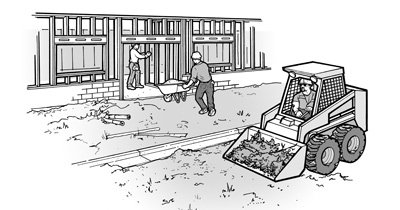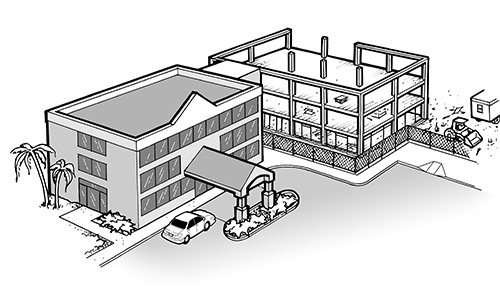Requirements for new construction
All newly constructed buildings and facilities used by businesses and nonprofit agencies must comply with the ADA Standards. These Standards specify what elements and spaces must be accessible, how many of a particular element must be accessible, and how to make spaces and elements accessible.

Construction workers are building a new building.
Examples of new construction
A growing automotive repair business decides to build a new facility. The owner knows the facility needs to be accessible but does not know what to do. He goes to the ADA Website or calls the ADA Information Line to determine what must be done. He learns that the ADA has requirements for:
• accessible parking,
• accessible entrances and exits,
• accessible sales and service counters,
• accessible toilet facilities, and
• an accessible route that connects all of these elements and spaces.
He asks the architect and contractor to study the requirements and to make sure the project complies with the ADA when done.
A developer plans to build a two-story building for retail use. Plans call for five stores on the first floor and three on the second floor. The developer has heard that the ADA does not require elevators in buildings that have less than three stories. He calls the ADA Information Line to confirm this. He finds out that elevators are required in some two-story buildings – including buildings that contain five or more retail establishments if at least one of them is located on the second story.
A restaurant owner decides to build a new restaurant, with indoor and outdoor seating areas. She figures the indoor seating area is surely covered by the ADA, but she is not sure about the outdoor seating area. She reviews the ADA Standards and the regulations for businesses on the ADA Website or calls the ADA Information Line, and learns that both indoor and outdoor seating areas must be accessible.
The owner of a small portrait gallery decides to locate her business in one section of the new home she is building. She figures the ADA will apply to the business portion of the structure but not the residential portion. She checks with the ADA Website or calls the ADA Information Line and learns that she is correct. All areas used by the business must comply with the ADA Standards, but the areas used exclusively as a residence are not covered by the ADA.
The owner of a card shop rents space in a building. The lease allows him to build it out to suit his needs. All partitions, finishes, counters, and other elements added by the card shop owner must comply with the ADA Standards.
Additions
When a building is expanded, the completely new spaces or elements that are constructed as part of the addition must meet the ADA Standards for new construction. The term “addition” refers to any expansion, extension, or increase in the gross floor area of an existing building or facility. An accessible route from the existing space to the added space is usually required.




banner.jpg)








